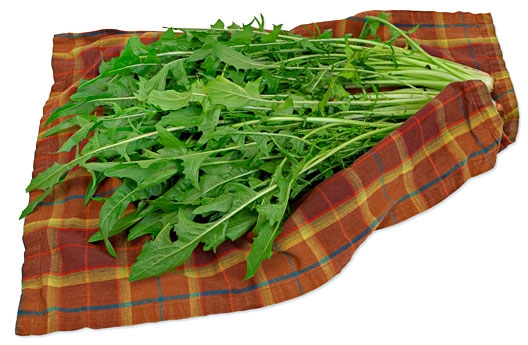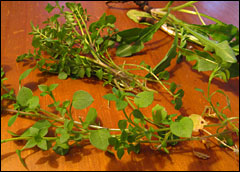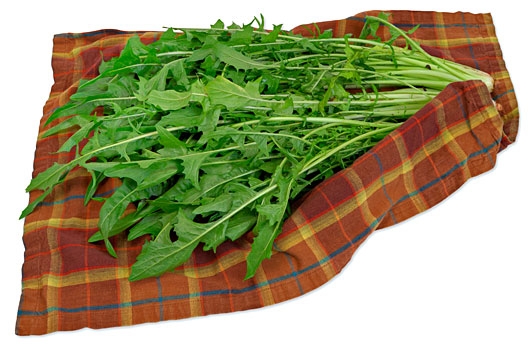
You can’t beat them, you might as well eat them.
Here in central North Carolina, the harbingers of spring have arrived. No, not daffodils. I’m talking about my favorite wild greens: pepper cress and dandelions. Just this week, I’ve tucked handfuls of these herbs into sandwiches, topped pizza with them, and folded some into soft scrambled eggs. Their peppery kick and bittersweet bite are just what I need after a winter of sweet, earthy, and starchy root vegetables.
Almost everyone I’ve encountered loves young spring greens — even if they don’t know it. For the uninitiated, I wait until the first convincing bite has been taken before I divulge that these delicious “gourmet” greens are what they have likely passed over many times as weeds in their own back yards. At this time of year, many folks walk right past a robust stand of free greens on their way to buy some California-grown arugula or a hydroponic watercress that pales in comparison, in both taste and nutrition.
I will not pretend that amateur foraging offers any measureable economic advantage, but it certainly changes the way you see the world. Appreciating these foods means appreciating the landscapes from which they spring. Gathered along roadsides, riverbanks, and field edges, wild foods provide an intimate interaction with nature and proof of its nourishing power. You begin to appreciate the traditional knowledge and the cultures that excelled in using these herbs.
Walk on the Wild Side
A common misconception is that by eating wild foods, we endanger them. But the opposite has been proven true. Even hunting wild game has been shown to increase awareness and lead to conservation. Think how much less herbicidal Americans would be if they could look at their yards and see salad-bowl potential.
Wild greens are a natural entry into the world of foraging since they are easy to identify, easy to prepare, and ubiquitous. You needn’t be an expert or be able to identify every weed in your yard. Just knowing how to identify one, like dandelions, is a great place to start. Here’s one guide to stalking wild greens (and here’s a look specifically at pepper grass). I also recommend signing up for a native plant walk in your area.

Chickweed, pepper cress, and dandelion, ready
for their close-up.
There is no need to “make time” to go foraging. Just pay attention when you walk to the mailbox, or when you are weeding your flower beds and getting ready for spring mulching. You’re sure to find plenty. Urban dwellers can play this game too. In New York City, “Wildman” Steve Brill is famous for his foraging tours of Central and Prospect Parks.
And in New Orleans, Creole women have raised urban foraging to the level of art. In the coming weeks, a few of them will be scouring vacant lots for pepper grass, a peppery wild herb and prized Native American ingredient in their traditional Lenten dish of gumbo z’herbes. Unfortunately, this venerable New Orleans tradition almost exclusively lies with the generation that is currently passing away.
Gumbo Goes Green
Gumbo z’herbes was first served by the Creoles of New Orleans during Holy Week, the week before Easter. It is said that after so many days of abstinence and fasting during Lent, this conglomeration of green supplied needed rejuvenation. The dish is rarely seen outside the forty-day Lenten season that runs from Ash Wednesday (or the day after Fat Tuesday) until Holy Saturday, the day before Easter. Peculiar to New Orleans, this dish bears the name gumbo even when, in its simplest form, it doesn’t contain classic gumbo ingredients like okra, roux, and gumbo file (powdered sassafras). Often it isn’t even served with rice.
Some say the dish should be made with at least seven greens. Others say as many as fifteen, but definitely an odd number for good luck. Most agree the more greens, the merrier, because for every green that cooks put into the gumbo, they’ll make a new friend that year. It is possible that pepper grass first made it into the pot of gumbo simply to bump up the numbers, and thus the luck, but it is prized today for improving the fragrance and the flavor of the dish.
Because it’s a Lenten dish, gumbo z’herbes traditionally is made without meat, though it does usually contain meat stock. That rule is often honored in the breach; Leah Chase, the beloved queen of the Creoles and authority on Creole cuisine, serves a gumbo z’herbes overflowing with many kinds of meat — pork, beef, chicken, and several types of sausage. Thankfully, we don’t need to understand the rules to appreciate the dish. Vegetarian or not, it is utterly delicious and a nutritional powerhouse to boot.
The version below utilizes a combination of cultivated and wild greens — and does include roux and gumbo file. Before you attempt to make it, know it will take time. The work is simple, but washing and picking over this many greens isn’t a fast process. Perhaps no one said it better than Southern writer Eugene Walter, whose instructions for preparing a pot of greens begins: “Take a day off and wash, wash, wash 3 or 4 big bunches of fresh (yes, I said fresh) turnip greens, younger the better … This takes time … put on some Mozart ….” One other note: this recipe makes a substantial amount — it’s simply difficult to make a dish with at least seven kinds of greens that doesn’t feed a crowd. Host a dinner party to celebrate the coming of spring, or halve the recipe. Whatever you do, make this dish. It is likely the only time that you will have an excuse to buy every type of green you see at the market, and hopefully, a few from your lawn or neighborhood as well.

Gumbo Z’Herbes
Don’t worry too much about exact measurements — gumbo famously grows to fill the pot. Just be sure to use an odd number of greens for luck, and remember: the greater the variety, the better.
Since there seems to be no quintessential recipe for gumbo z’herbes, I have given you options. Make it purely vegetarian with a homemade rich vegetable stock (or keep it simple and just use the greens blanching water); or use a smoked-pork or poultry stock. Then, only if you so desire, throw in some sausage, the way Leah Chase would do. (She has also been known to supplement some frozen or pre-washed greens as well, which cuts down on the prep time significantly.)
Serves 8-10
Dandelion greens
Collards
Mustard Greens
Turnip Greens
Cabbage
Creasy Greens
Pepper Grass
Watercress
Nettles
Chicory
Spinach
Radish Tops
Carrot Tops
Beet Greens
Green onion tops (or wild onions)
Parsley
Arugula
Chickweed
1/2 pound smoked pork sausage, optional, sliced into half-inch thick rounds
1/2 pound andouille or other hot sausage, optional, sliced into half-inch thick rounds
1/2 cup fat of your choice — vegetable oil, bacon drippings, or lard from pastured hogs
1 large yellow onion, chopped
1 rib celery, chopped
1 green bell or poblano pepper, chopped
6 cloves garlic, smashed
2 bay leaves
A few twigs of fresh thyme or 1 teaspoon dried
1/2 teaspoon ground allspice
1 teaspoon of ground cayenne
Salt
Black pepper
Gumbo file powder, for serving
Wash all of your greens very, very well to remove any grit. Remove tough stems and discolored leaves and discard.
Bring a large stockpot (2-3 gallons) of lightly salted water (about 1 teaspoon per gallon of water) to a boil. In batches, blanch the greens until they are tender (30 seconds to 3 minutes depending on toughness). Transfer the blanched greens to a colander, and continue using the same water to blanch all of your greens. Discard the cooking liquid and place the empty pot back on the stove. Alternately, you may steam the greens if you prefer.
When the greens are cool to the touch, transfer them to a cutting board and chop them fine. You can also use a food processor. Place the chopped greens in the empty pot on the stove.
Add the sausage, if using, to the pot with the greens. Add 12 cups of vegetable or pork stock and bring to a boil. Turn down to a simmer.
In the meantime, make your roux. In a heavy 10″ skillet, heat the cup of fat over medium heat until hot. With a wooden spoon, stir in the flour. Continue cooking, stirring slowly but constantly, until the roux mixture is the color of peanut butter. Add the chopped onion, celery, green pepper, and garlic and cook until the onion is soft, about five minutes.
Whisk the roux into the greens mixture a spoonful at a time. Add the bay leaf, thyme, and cayenne to the gumbo. Taste for seasoning and add salt and black pepper to taste.
Continue simmering, stirring often for about an hour. Add more water or stock if at any time the gumbo gets too thick. It should be the consistency of a pureed soup.
Sprinkle a bit of the file powder on each bowl of gumbo.
Serve with long grained rice and hot sauce.
Rich and Smoky Pork Stock
4 quarts water
In a stockpot, cover the ham hocks with the water and bring to a boil. Turn down to a simmer, cover and cook for 2 hours. Strain the stock and cool. You have the option of chopping the meat from the ham hocks to include in your stock. Discard the bones and fat. Refrigerate the stock for a few hours to skim off the fat on top before using if desired. The stock can be made ahead and refrigerated for 1 week or frozen for up to 3 months.
Rich Vegetable Stock
4 carrots, sliced
2 parsnip, sliced
2 large onions, sliced
4 stalks celery, sliced
6 cloves of garlic, smashed
A large handful of parsley stalks (leaves attached is okay)
A handful of cilantro stalks
20 black peppercorns
A handful of fresh thyme twigs
1/2 cup white wine, optional
4 quarts water
2 Tablespoons barley miso or tamari soy sauce
Salt and pepper to taste
In a heavy-bottomed stockpot, heat the olive oil. Add the carrots, parsnips, onion, and celery and cook for 10 minutes, stirring occasionally until they are well browned. Add the garlic and cook for another couple of minutes until it is golden.
Add the parsley and cilantro stems, peppercorns, thyme, wine, and water. Bring to a boil, then turn down to a gentle simmer. Simmer until the vegetables are very tender, about 1 hour. Strain the stock, then add the miso or soy sauce and additional salt and pepper to taste. Refrigerate the stock for a few hours to skim off the fat on top before using if desired. The stock can be made ahead and refrigerated for 1 week or frozen for up to 3 months.



